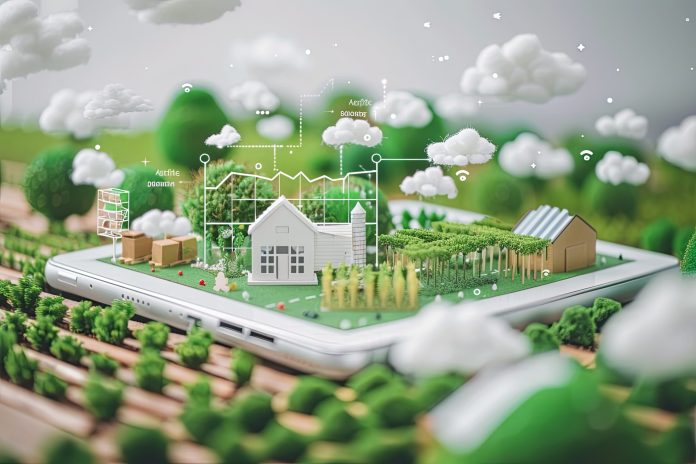[ad_1]
As concerns about environmental sustainability and energy efficiency continue to grow, homeowners are increasingly turning to green technologies to future-proof their properties.


Note: The integration of sustainable innovations is not just about reducing carbon footprints; it also involves enhancing property values and ensuring homes meet future standards and regulations.
This transition is driven by both evolving homeowner preferences and the tangible benefits that eco-friendly upgrades offer in terms of cost savings and environmental impact.


The Push Towards Sustainability: Exploring the Growing Demand for Eco-Friendly Homes
The surge in demand for eco-friendly homes is evident across the Australian property market.


Note: With rising energy prices and increased environmental awareness, homeowners are seeking ways to make their living spaces not only more economical but also environmentally sound. This shift is supported by stricter building regulations that favour sustainability.
Additionally, the market shows that homes with energy-efficient certifications often fetch higher prices, suggesting that investment in green technology can also be financially rewarding. The trend extends beyond individual homeowners to developers and investors who recognise the long-term benefits of sustainable building practices.
Key Innovations in Home Sustainability: A Look at the Latest Green Technologies
Technological advancements are at the forefront of the sustainable home movement, bringing a variety of options to homeowners looking to upgrade.
From high-efficiency heat pumps that offer significant reductions in heating costs to advanced insulation materials that drastically improve thermal performance, the choices are extensive and continually improving.


Note: Smart home technologies that optimise energy use are becoming commonplace, allowing for real-time energy management and reduced waste.
These technologies not only contribute to a home’s sustainability profile but also enhance comfort and convenience, proving that environmental responsibility can go hand-in-hand with modern living comforts.
Solar Power and Beyond: Diverse Energy Solutions for Every Home
Solar energy remains a cornerstone of home sustainability, but the scope of options extends far beyond traditional solar panels for your property.


Innovations such as solar roof tiles integrate seamlessly into the design of your home while providing the same energy-generating capabilities as conventional panels.
For properties where space or aesthetics are a concern, these solutions offer a discreet yet effective alternative.
Additionally, the integration of battery storage systems has revolutionised the use of solar power, allowing homeowners to store excess energy during peak production times for use during lower production periods.
This maximises the utility of solar installations, ensuring that homes can remain nearly self-sufficient in terms of energy. Furthermore, hybrid systems that combine solar power with other renewable sources like wind or geothermal energy are becoming more accessible, providing a robust solution for all-round energy independence.
Cost vs. Benefits: Analysing the Financial Implications of Sustainable Upgrades
Investing in sustainable technologies often involves an initial financial outlay; however, the long-term benefits can significantly outweigh these initial costs.
For example, the installation of solar panels may come with a considerable upfront price, but the reduction in energy bills and the potential increase in property value can provide substantial returns over time.
Government incentives, such as feed-in tariffs and grants for green improvements, also help offset the costs, making sustainable upgrades more accessible to a wider range of homeowners.
Moreover, properties equipped with green technologies tend to have a longer market lifespan and attract buyers willing to pay a premium for energy-efficient features.
Financial analysis shows that the return on investment for energy-efficient upgrades, especially in regions with high energy costs, can be compelling. By reducing dependency on external energy sources and minimising future energy price volatility, these investments secure financial stability and enhance the property’s appeal in an increasingly eco-conscious market.
Future Trends: Predictions for the Next Wave of Sustainable Home Technologies
As technology evolves, the future of home sustainability is poised to become even more integrated and intelligent. Expect to see the rise of smart grids that connect homes in a way that optimises energy efficiency across entire communities.


Note: These grids will allow homes to not only produce their own energy but also to share surplus power seamlessly with neighbours, creating micro-communities that are self-sustaining.
Moreover, advancements in materials science are expected to introduce super-efficient insulation materials and windows that radically reduce energy loss. Another promising area is the development of more efficient solar panels that can capture sunlight more effectively, even on cloudy days.
The integration of AI and IoT in home energy systems is also likely to become standard, enabling homes to automatically adjust energy consumption based on real-time data, further enhancing efficiency and reducing waste.


Getting Started: Steps to Take Today for a More Sustainable Tomorrow
Embarking on the journey to make your home more sustainable might seem daunting, but starting small can lead to significant impacts.


Tips: One of the first steps is to conduct an energy audit of your property to identify where improvements can be made. This can highlight simple changes, such as switching to LED lighting or installing more efficient appliances, that provide immediate benefits.
For those ready to make larger investments, upgrading to a high-efficiency boiler or installing double-glazed windows can drastically improve a home’s thermal efficiency. It’s also beneficial to stay informed about local government incentives that could help subsidise initial costs.


Note: Starting with these manageable steps not only positions homeowners to take advantage of more complex technologies as they become mainstream but also immediately starts to reduce utility bills and increase home comfort.
[ad_2]
Source link


